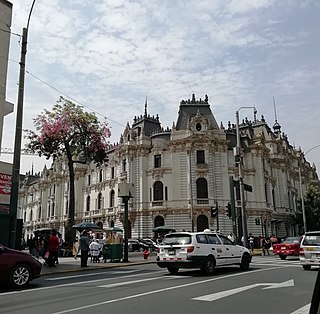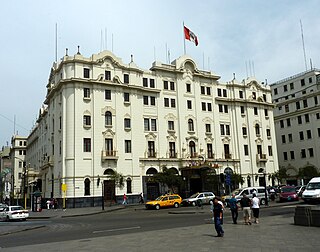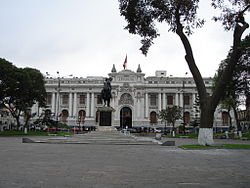
The Museo Nacional de Arqueología Antropología e Historia del Perú is the largest and oldest museum in Peru, located on Plaza Bolívar in the Pueblo Libre district of Lima. The museum houses more than 100,000 artifacts spanning the entire history of human occupation in what is now Peru. Highlights include the Raimondi Stele and the Tello Obelisk from Chavín de Huantar, and an impressive scale model of the Incan citadel, Machu Picchu. The museum is currently (2023) under restoration and very few rooms are open for visitors.

Caraz is a town in the Caraz District in the southeastern part of Huaylas Province of the Ancash Region in Peru.

The Peruvian War of Independence was a series of military conflicts in Peru from 1809 to 1826 that resulted in the country's independence from the Spanish Empire. Part of the broader Spanish American wars of independence, it led to the dissolution of the Spanish Viceroyalty of Peru.

The Jirón de la Unión, or Union Street, is a pedestrian street located in the Historic Centre of Lima, part of the capital of Peru. For many decades it was the most important boulevards of the city, often described as the most aristocratic, where many of the most affluent citizens of the city and most powerful men around the world would meet. Subsequently, with the deterioration of the center of Lima, the Jirón de la Unión lost its aristocratic character and became completely commercialized.

The Archbishop's Palace of Lima, the capital of Peru, is the residence of the Archbishop of Lima, and the administrative headquarters of the Archdiocese of Lima. It is located on the Plaza Mayor of Lima, in the Historic Centre of Lima.

The Plaza Mayor de Lima, or Plaza de Armas de Lima, is considered one of the birthplaces of the city of Lima, as well as the core of the city. Located in the Historic Centre of Lima, it is surrounded by the Government Palace, Lima Metropolitan Cathedral, Archbishop's Palace of Lima, the Municipal Palace, and the Palacio de la Unión.
La Cruz del Viajero is a monumental cross located in what now Pueblo Libre, a district of the city of Lima, Peru. It was erected in 1579 by Catholic missionaries. Travellers would stop at the cross to ask for protection on the road to the port of Callao, a route which was beset by bandits. In 1759 the cross was moved 100 metres from its original location to a plaza that bears its name on the corner of Torre Tagle and Julio C. Tello streets. Both José de San Martín and Simón Bolívar are said to have knelt before the cross.

The Plaza San Martín is one of the most representative public spaces of the city of Lima, Peru. It is located at the ninth block of Colmena avenue, within the Historic Centre of Lima which was declared a World Heritage Site in 1988 by UNESCO. It is located near the Plaza Mayor of Lima and is connected to it by the Jiron de la Union. Its central monument gives homage to Peru's liberator, José de San Martín.

The Palacio Municipal de Lima or City Hall of Lima is a public building that serves as headquarters of the Metropolitan Municipality of Lima. It is located on the street Portal de Escribanos, block 3 of Jirón de la Unión, and in front of the Plaza Mayor of Lima's historic centre.

The Casa de Correos y Telegrafos is the central post office of the city of Lima, Peru. The building is located in the Historic center of Lima near the Plaza Mayor. The building was constructed in 1897 in a French architectural style. Additionally, the building houses the National Postal and Philatelic Museum. Besides displaying exhibits relating to postal service, the museum showcases exhibits relating to Limean history. The building is located along Piura street and its interior is lined with shops. Its facade contains a clock, and a bronze lion depicted with its snout open and devouring correspondence. The building occupies an area of 6,537 square meters.

The Gran Hotel Bolívar, is a historic hotel located on Plaza San Martín in Lima, Peru. Designed by noted Peruvian architect Rafael Marquina, it was built in 1924 and was the first large, modern hotel built in Lima.

The Basilica and Convent of San Agustín is located in the historic centre of Lima, in front of the square of the same name, and a few blocks from the Plaza Mayor of the capital. Its care is, since its foundation, run by the Augustinian friars, and belongs to the Province of Our Lady of Grace of Peru.

Simon Bolivar, also known as General Bolivar, is a bronze equestrian statue of Simón Bolívar by Adamo Tadolini. There are three casts. The original is located in the Plaza Bolívar in Lima, the first copy is in the Plaza Bolívar in Caracas and the second copy is in United Nations Plaza in San Francisco, California.

Bolívar Square in Caracas is one of the most important and recognized Venezuelan public spaces. It is located in the center of the first 25 blocks of Caracas when it was founded as "Santiago de León de Caracas" in 1567. It is in the historic center of the city in the Cathedral Parish of the Libertador Municipality.

The Plaza Bolognesi is a roundabout located in the Lima District and the Breña District, in the capital of Peru. It is located at the intersection of Brasil Avenue, Arica Avenue, Alfonso Ugarte Avenue, Guzmán Blanco Avenue, and 9 December Avenue.

The Palacio de la Magdalena is a viceregal house located in the district of Pueblo Libre in Lima. It is located near the Plaza de los Libertadores, and is also known as the Quinta de los Libertadores. The building was declared a national monument in 1972.

Italy Square, formerly known as Saint Anne's Square, is a public square in the Barrios Altos neighbourhood of Lima, Peru. It was the second square built by the Spanish during the colonial era and later served as one of the four squares where the independence of Peru was declared in the city.

The Plazoleta de la Merced, also known as the Plazuela de la Merced, is a public square located in front of the Basilica and Convent of Nuestra Señora de la Merced, at the fifth block of the Jirón de la Unión and its intersection with the Jirón Huancavelica, in the historic centre of Lima, Peru.

Jirón Junín is a major street in the Damero de Pizarro, located in the historic centre of Lima, Peru. The street starts at its intersection with the Jirón de la Unión and continues for 19 blocks until it reaches Nicolás Ayllón Avenue.






















